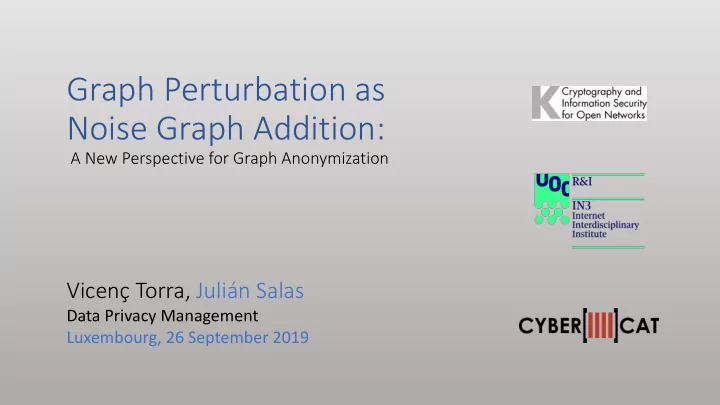

Graph Perturbation as Noise Graph Addition: A New Perspective for Graph Anonymization Vicenç Torra, Julián Salas Data Privacy Management Luxembourg, 26 September 2019
Outline 1. Introduction • Motivations and objectives • Random graph models 2. Formalizing noise addition for graphs
Motivations • Several masking methods for graphs: There is a large number of adhoc methods based on removing/adding edges/nodes. Most of them are evaluated empirically. • Noise addition for standard databases: Is a well-structured approach with a solid mathematical/statistical basis.
Noise addition For standard databases • Given a value x for variable V with mean μ and variance σ 2 Replace x by x + ε with ε∼N(0, σ 2 ).
Privacy models • K-anonymity: Modify the data so that intruders cannot find a record in the database. Protect record among k indistinguishable records. • Differential privacy: Given a query, avoid disclosure from the outcome of the query. Add noise into the outcome. • Protect against reidentification: Modify the data so that intruders cannot find a record in the database. Add noise into the data.
Objective • Develop a sound approach for graph masking. Based on the analogy of noise addition for graphs. We use Random Graphs & Graph Addition
Random Graphs Basic models • Gilbert model: (n,p) n nodes and each edge is chosen with probability p . • Erdös-Renyi: G(n,e) A uniform probability of all graphs with n nodes and e edges. Both are asymptotically equivalent.
Online social networks 𝑄 𝑙 ~𝑙 −𝛿 OSN are sparse & their degrees follow a power-law:
Random Graphs Different models • Models based on a given degree sequence . (n, 𝑒 𝑜 ) (n, 𝑒 𝑜 ) uniform probability of all graphs with n nodes, degree sequence 𝑒 𝑜 . • Add constraints to graphs: e.g., the degree sequence, spatial/ temporal constraints on the nodes.
Graph Addition Formalization Given two graphs G 1 (V, 𝐹 1 ) and G 2 (V’, 𝐹 2 ) with V⊆V’ ; we define the addition of G 1 and G 2 as the graph G(V’, 𝐹 ) where: E = {e : e ∈ V ∧ e ∉ V’ } ∪ {e : e ∉ V ∧ e ∈ V’ } G = G 1 ⨁G 2 Note that ⨁ is an exclusive-or of edges, most general definition is based on alignments.
Noise Graph Addition Methods For any graph G choose a noise-graph G’ from to add noise to G: G ⨁G’ • Previous methods can be expressed in this way by adding constraints to the family of graphs .
Noise Graph Addition Previous methods: examples Changing m edges from the original graph. Define: = {G’ : |E(G’)|=m} • If we restrict to be the family of graphs 𝐻 such that |E(G’)| = 2m and |E(G’) ∩ E(G)| = m , then we are adding m edges and deleting m other edges .
Noise Graph Addition Previous methods: examples Random sparsification (for a probability p): For each edge do independent Bernoulli trial. Leave the edge in case of success and remove otherwise. Our method, use: = (n, 1 − p) ∩ G Add G ⨁G’ for some G’ ∈
Noise Graph Addition Previous methods: examples Degree preserving randomization Define: = {G’ : V(G’) = i, j, k, l ⊆V(G); ij, kl ∈ E(G’ ) and jk, li ∉ E(G’ )} is the set of alternating 4-circuits of G. 𝑛 G ′ 𝑗 G ⨁ 𝑗=1 Following this procedure for m large enough is equivalent to randomizing G to obtain all the graphs (n, 𝑒 𝑜 ) .
Noise Graph Addition New method Local randomization 𝑢 : V( G 𝑣 𝑢 ) =u, u 1 , … , u 𝑢 ; E( G 𝑣 𝑢 )= u u 1 , … , uu 𝑢 } Define: = { G 𝑣 𝑢 changes t- random edges incident to vertex u ∈ V(G). Then, G ⨁G 𝑣 • So we can apply local t- randomization for all u ∈ V(G) to obtain the graph 𝐻 𝑢 = 𝐻 ⨁ u ∈ V(G) G 𝑣 𝑢
ҧ ҧ Local Randomization Risk properties Adversary’s prior and posterior probabilities to predict whether there is a sensitive link between i, j ∈ V(G) by exploiting the degree d 𝑗 and access to 𝐻 𝑢 d 𝑗 P(𝑏 ij = 1) equals: 𝑜−1 d 𝑗 ( ҧ 𝑢 2 + 𝑢 2 ) 𝑢 = 1) equals: P(𝑏 ij = 1|𝑏 𝑗𝑘 d 𝑗 𝑢 2 + 𝑢 2 +2 d 𝑗 ( ҧ 𝑢𝑢) 2 d 𝑗 ( ҧ 𝑢 = 0) equals: 𝑢𝑢) P(𝑏 ij = 1|𝑏 𝑗𝑘 𝑢 2 + 𝑢 2 +2 d 𝑗 ( ҧ d 𝑗 𝑢𝑢)
The most general noise From Gilbert model Let G 1 (V, 𝐹 1 ) an arbitrary graph with n 1 = 𝐹 1 and G 2 (V, 𝐹 2 ) generated from a Gilbert model with n 2 = 𝐹 2 . Then G= G 1 ⨁G 2 will have on average: n 2 𝑢− n 1 + n 1 𝑢− n 2 edges. 𝑢 Where t =|V|(|V|-1)/2.
Summary Different approaches
Conclusions • We defined noise graph addition. Some existing methods can be seen from this perspective. Proven some properties. • This approach permits a more systematic study of graph perturbation.
Thank you Any questions?
Recommend
More recommend